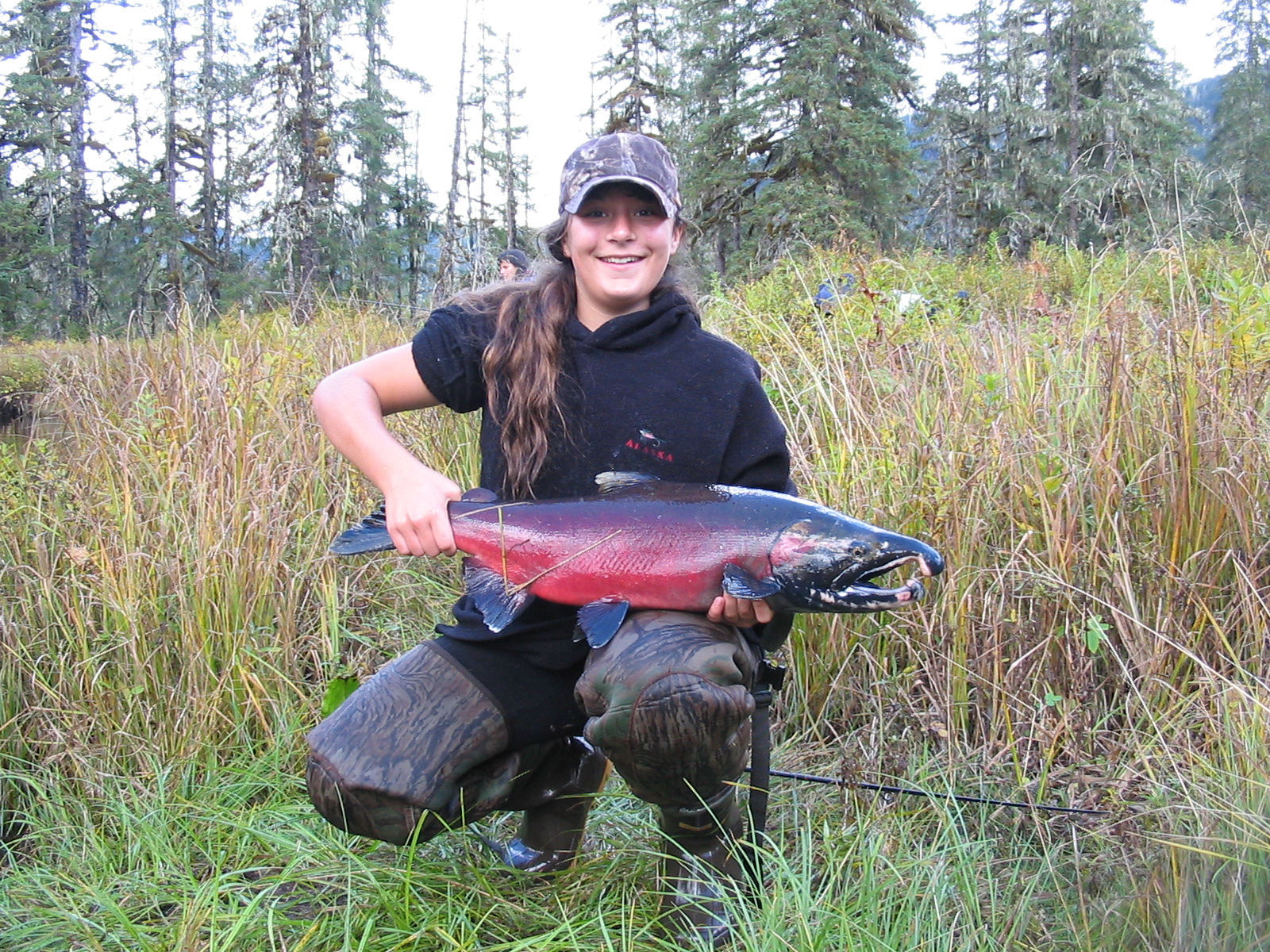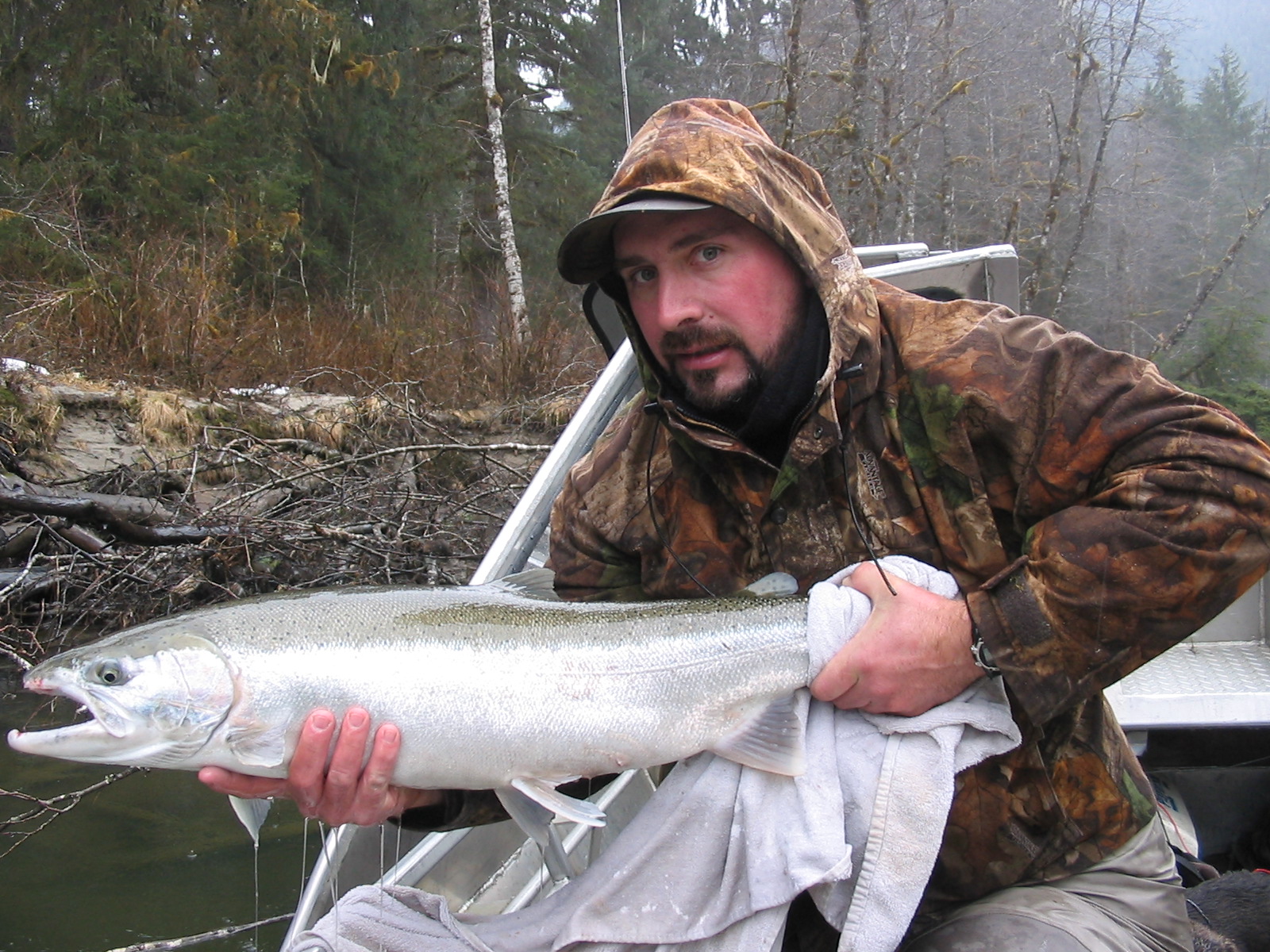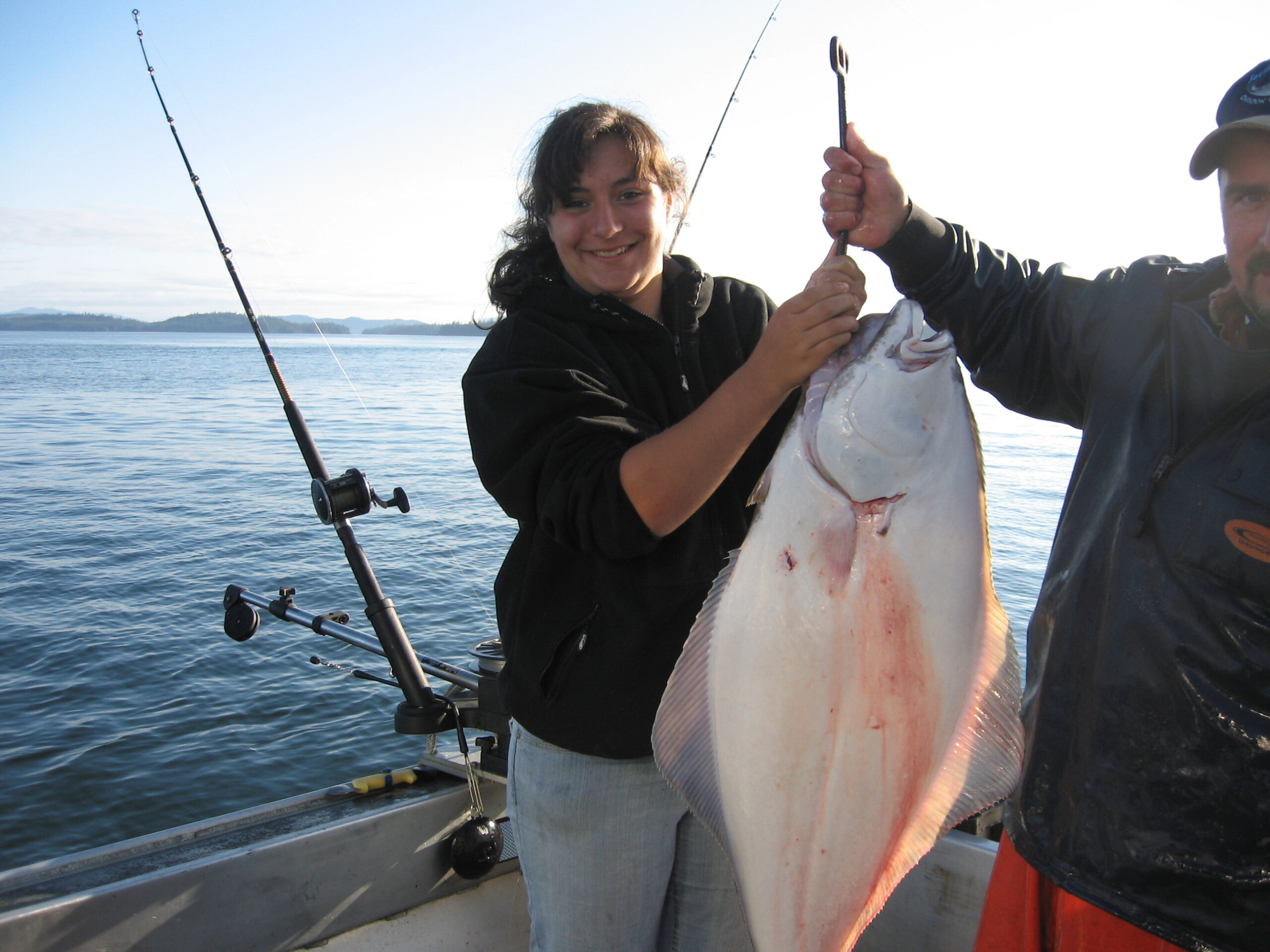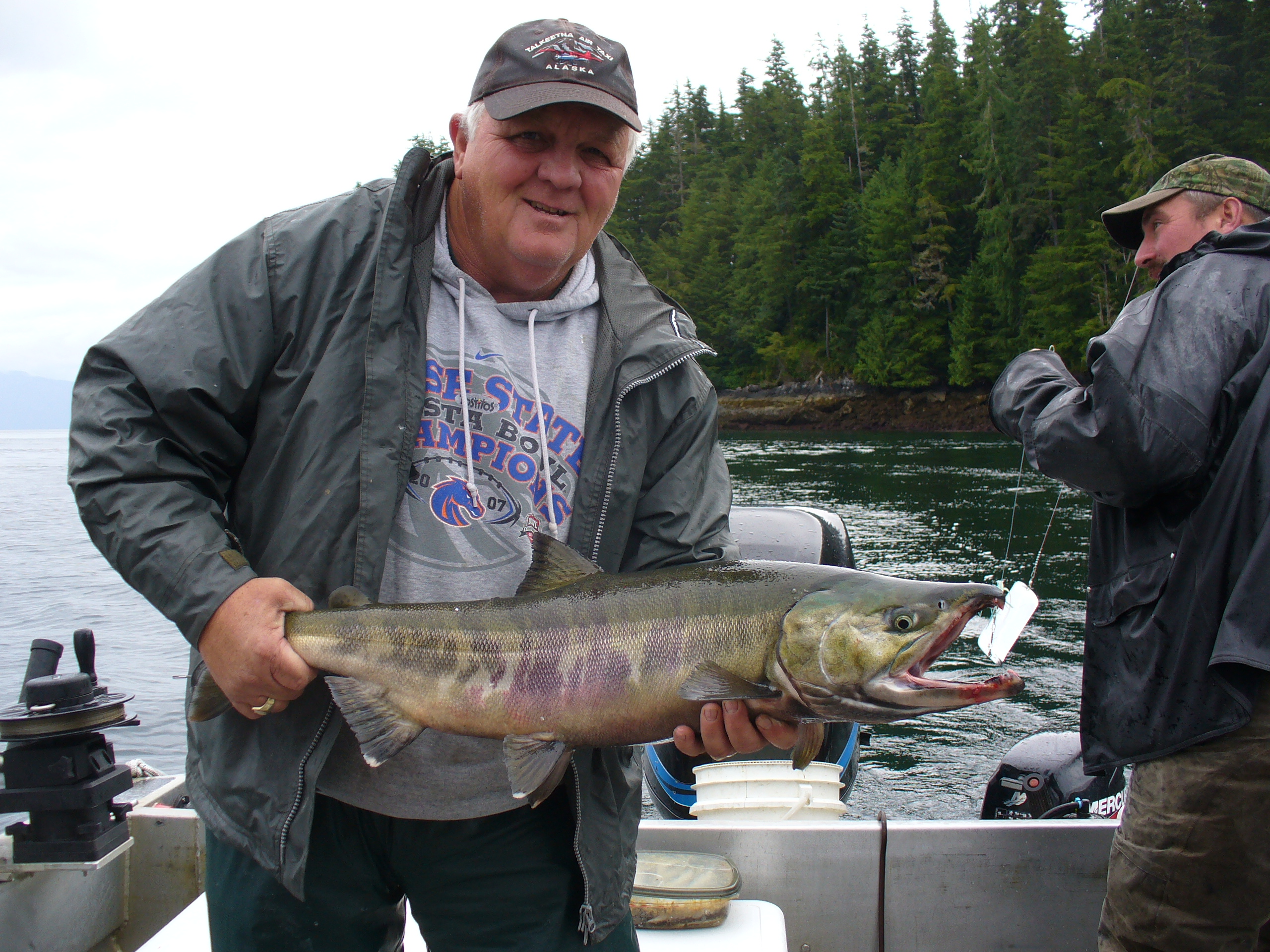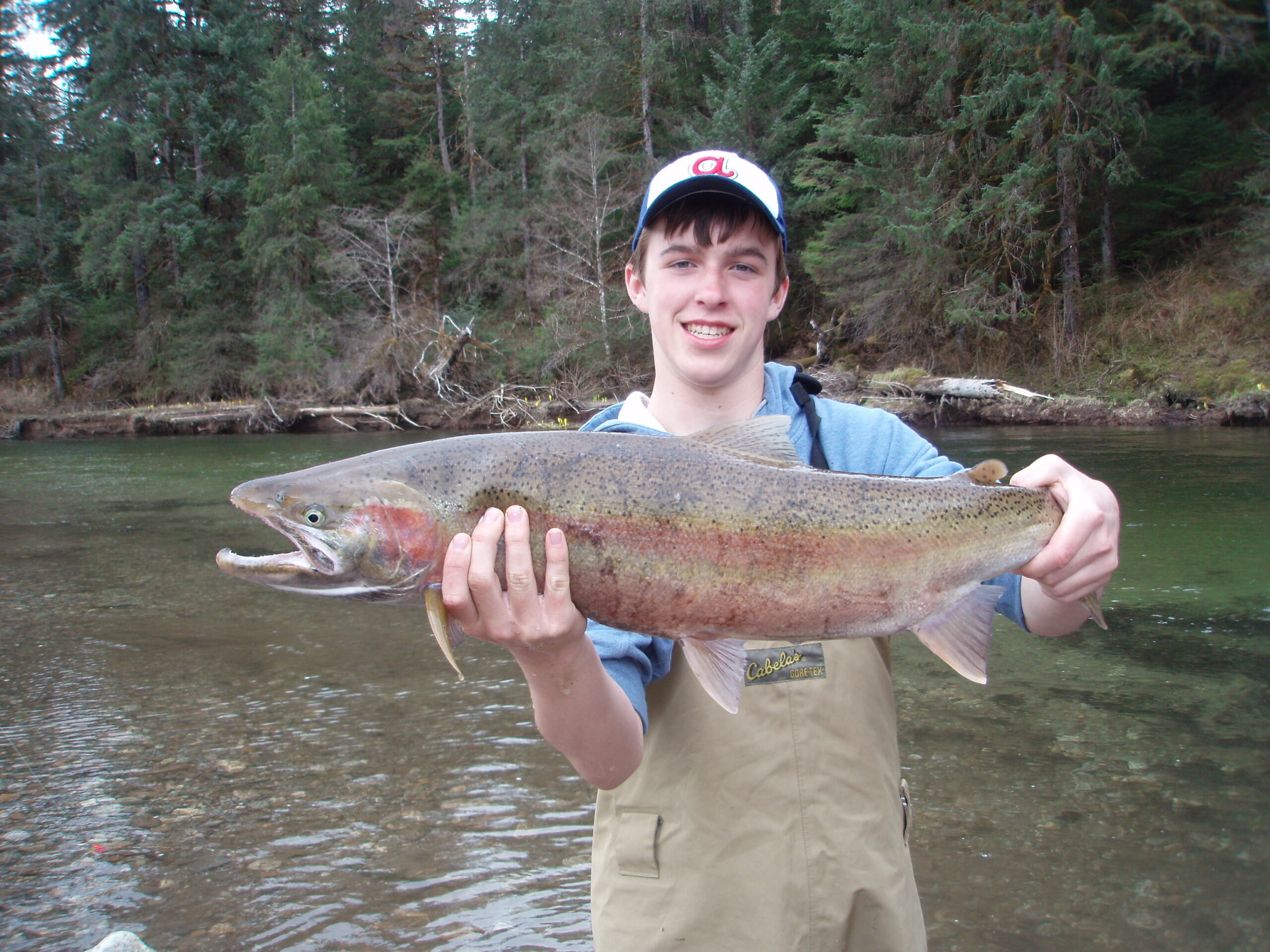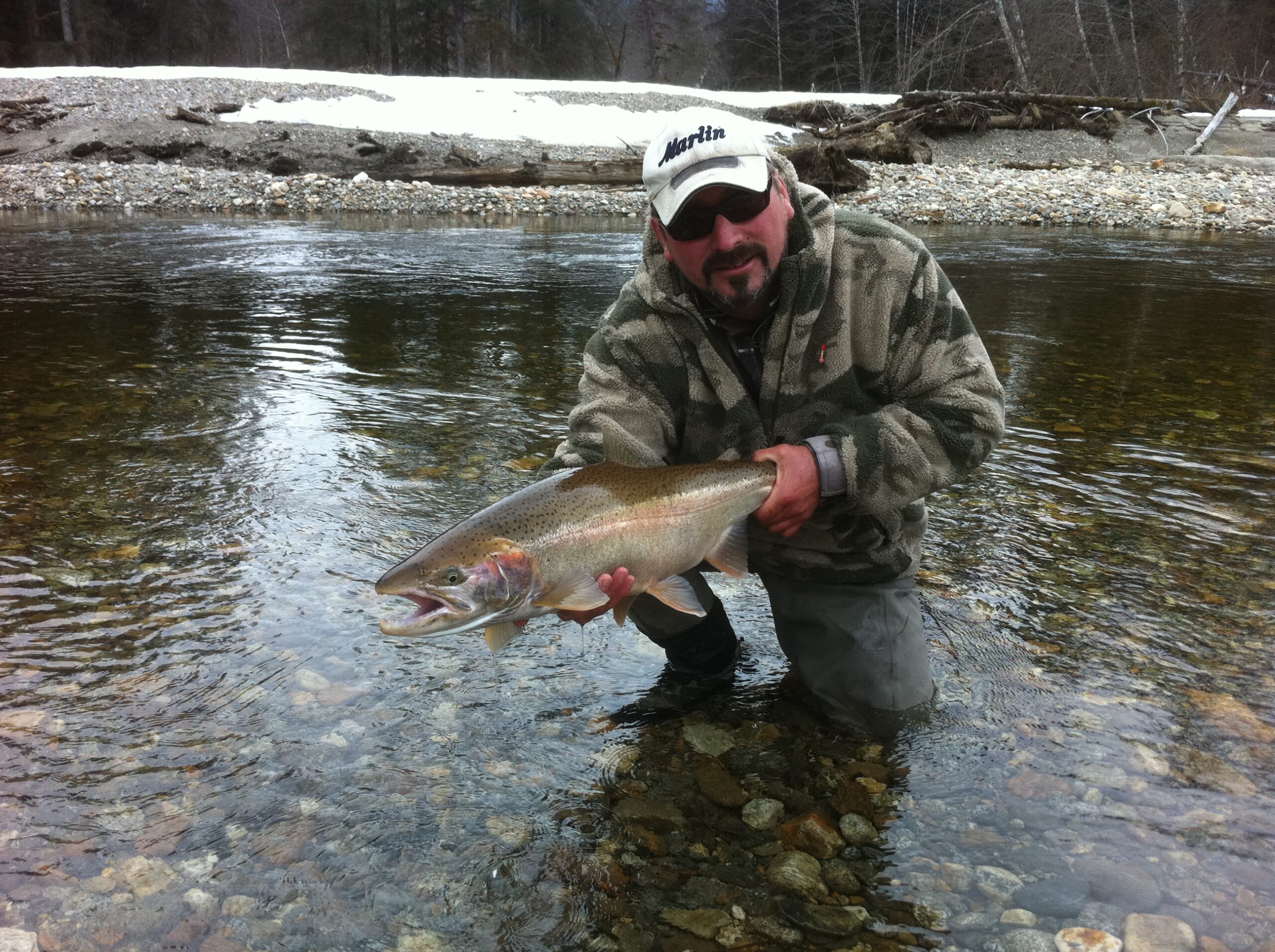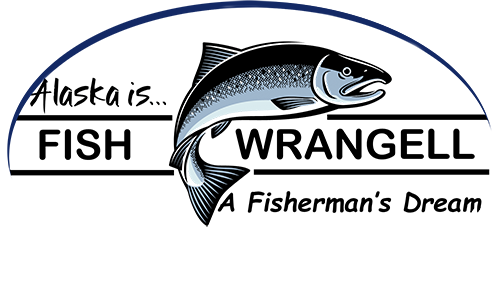

Suggested Packing List
Weather in Alaska can be unpredictable, and adequate outdoor clothing is essential for your stay with us. Generally, daytime temperatures range from the 50’s to the 70’s with some days reaching into the 80’s. Traditionally, July has the warmest weather; however, Alaskan weather changes often and can quickly go from sunny and warm to wet and cold during any month of the season. There is a chance of freezing temperatures in early June and September. “Plan Ahead and Prepare” is a good motto to follow!
The best way to dress for a fishing trip in Alaska is in layers. Polypro, capilene, or wool all keep you warm even when wet and are excellent first and second layers. Always have rain gear with you even if it’s clear and sunny in the morning. Please bring enough wool or synthetic socks for your entire lodge stay. Though cotton socks are fine for around the lodge, you’ll want to avoid wearing anything cotton while fishing. Please note that laundry facilities are not available at the lodge.
RAIN GEAR: A good quality two-piece rainsuit with a hood is a must. It should be made of coated nylon, with factory-sealed seams. The expensive “Gore-tex” variety is not really necessary; however, you may opt for this if you think you may have use for it again. Please do not bring a plastic poncho or vinyl rainsuit because these types tear too easily and quickly becomes non-functional.
WADERS: (Trout and Salmon fishing) Breathable or neoprene, your preference.
SHOES or BOOTS: To wear in the powerboats or at the lodge when you’re not fishing. Footwear should be comfortable, lightweight, and water repellent. Nike, Vasque, Hi-Tec and Merrell all make lightweight hiking boots that are moderately priced. We provide hip waders for trout and sockeye fishing on the Upper Kenai.
PANTS or JEANS: Comfortable and durable. Include a pair of shorts for the sauna (or for the occasional warm sunny day).
SHIRTS: T-shirts, flannel shirts, lightweight long sleeve shirts, and turtlenecks are all good options.
WARM JACKET/SWEATER/VEST : A fleece or pile jacket, vest and/or wool sweater are great layers for extra warmth.
LONG UNDERWEAR: Do not bring cotton long underwear. Polypropylene, capilene, or wool tops and bottoms are good choices.
FLEECE PANTS: For cold mornings in August and September, these are great under breathable waders.
SOCKS: Wool or synthetic socks are best.
GLOVES: Lightweight wool or fleece gloves.
WOOL KNIT CAP: You won’t be sorry you brought this!
BRIMMED HAT: For sun and rain protection.
POLARIZED SUNGLASSES: Great for glare off the water.
NO-See-UM Head nets.
DAY PACK or HIP PACK: We have plenty of dry storage room on the boats for extra gear and warm clothing.
INSECT REPELLENT: The higher the percentage of DEET (N, N-diethyl-meta-toluamide), the more effective it is against mosquitoes. Natural repellents containing Citronella are less effective, but are gentler on your skin. Creams and pumps are more environmentally friendly than aerosols.
OPTIONAL: Quart water bottle, binoculars, camera (extra film and batteries), sport sandals (for sauna), travel alarm clock, sunscreen, personal fishing tackle, flashlight (August and September).
Do I need a fishing license?
Anyone over the age of 16 is required by law to purchase an Alaska fishing license. If you are fishing for king salmon you will also need a king salmon stamp. One-day licenses cost $10 per person and one-day king stamps cost $20 per person. Anyone under the age of 16 is not required to purchase a fishing license, but will need a free harvest record card. Licenses are not included in our trip costs and must be purchased prior to your fishing trip. If you’d like to purchase your license in advance, you may apply online at www.admin.adfg.state.ak.us/license (note: for online purchases please allow at least two weeks to receive your license in the mail). Fishing licenses and king salmon stamps are also available for purchase at most gas stations and convenience stores here in Alaska.
What equipment is provided?
We provide all tackle, top-notch fishing gear, rain jackets, rain pants, hip waders and U.S. Coast Guard approved personal flotation devices. If you prefer, you are also welcome to bring along your own favorite fishing tackle, waterproof rain gear and waders. Please contact us for tackle and gear recommendations.
What should I bring?
Bring along plenty of warm clothes! The best way to dress for a fishing trip in Alaska is in layers. Polypro, capilene or wool all keep you warm even when wet and are excellent first and second layers. We suggest bringing a hat, gloves, a warm jacket, long underwear and an extra pair of socks. Always have rain gear with you even if it’s clear and sunny in the morning. Some other helpful items to bring along are insect repellant and polarized sunglasses, as both can be handy on the river. Please refer to our Packing List for our recommendations on what to bring.
What can I fish for?
We will do our best to provide the most exciting fishing available on any given day. June through July, we’ll fish for giant king salmon. In August and September, we’ll fish for silver salmon. June through September we fish for dolly varden and rainbow trout
Can I keep what I catch?
We keep all salt water catches.
Can I bring my camera and binoculars on the boat?
Definitely. You will want to take many pictures of your fish, magnificent scenery and wildlife along the lakes and streams. Your gear will remain relatively dry in the boat storage spaces, and we provide waterproof bags for protection from the occasional splash.
Will I see wildlife?
The Wrangell Island area is home to moose, eagles, bears, beavers, otters, and numerous fish and waterfowl. Wildlife sightings vary on each trip. Your guide will share with you ways to search for wildlife and recognize wildlife signs.
What if I’ve never fished before?
No previous knowledge of fishing is necessary. You need only be in average physical condition and have a hearty appetite for adventure. Fishing in Alaska is fun regardless of your experience level and our guides will teach you their successful techniques.
How many people are in each fishing boat?
There are usually two to four people per boat on the fishing trips.
Can my family fish with me?
We often guide groups or families with various ages and fishing abilities. Children over the age of 12 are able to handle the Alaska fishing challenges and frequently catch the largest fish in the group! There’s usually enough fishing adventure and wildlife sightings to keep the entire family entertained.
Are there bathroom facilities along the river?
On most days we’ll be fishing through some undeveloped wilderness areas with enough trees for everyone.
What’s the weather going to be like?
Alaskan weather is unpredictable and can change hourly. Even on the sunniest days of summer, the temperature on the lakes and streams can feel cool. Your guides will offer advice on how to layer your clothing to maximize comfort. For advance suggestions, please refer to our recommended Packing List.
Our Boats:
26′ Royal Coachman
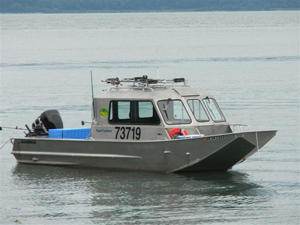
Saltwater travel only
Fishes group sizes 2 to 4 comfortable,
Seating up to 6.
This boat is covered cabin and heated if needed.
17′ Muddler Minnow
Is open boat with rap-a-round front windows. a picture of the boat or boats would help. If you do not have one let me know.
This is a freshwater fishing boat. We provide waders, shoes, fly and spin rods, all the hooks are provided. Float coats for warmth and wind break are provided.
Can travel in 4 inches of water
No big hikes in most cases, just start fishing where the boat parks.
Don’t miss out on your opportunity for a fishing trip of a lifetime!
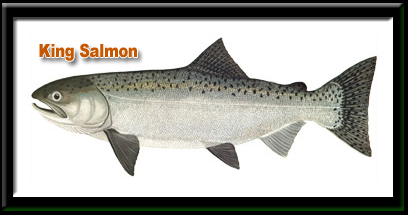 The Chinook is blue-green, red, or purple on the back and top of the head, with silvery sides and white ventral surfaces. It has black spots on its tail and the upper half of its body. Chinook have a Black gum line which is present in both salt and freshwater. Adult fish range in size from 24 to 36 in (61 to 91 cm), but may be up to 58 in (1,500 mm) in length; they average 10 to 50 lb (4.5 to 22.7 kg), but may reach 130 lb (59 kg). The current sport-caught world record, 97.25 lb (44.11 kg), was caught on May 17, 1985, in the Kenai River (Kenai Peninsula, Alaska). The commercial catch world record is 126 lb (57 kg) caught near Rivers Inlet, British Columbia, in the late 1970s.
The Chinook is blue-green, red, or purple on the back and top of the head, with silvery sides and white ventral surfaces. It has black spots on its tail and the upper half of its body. Chinook have a Black gum line which is present in both salt and freshwater. Adult fish range in size from 24 to 36 in (61 to 91 cm), but may be up to 58 in (1,500 mm) in length; they average 10 to 50 lb (4.5 to 22.7 kg), but may reach 130 lb (59 kg). The current sport-caught world record, 97.25 lb (44.11 kg), was caught on May 17, 1985, in the Kenai River (Kenai Peninsula, Alaska). The commercial catch world record is 126 lb (57 kg) caught near Rivers Inlet, British Columbia, in the late 1970s.
Chinook may spend one to eight years in the ocean (averaging from three to four years)[10] before returning to their home rivers to spawn. Chinook spawn in larger and deeper waters than other salmon species and can be found on the spawning redds (nests) from September to December. The female salmon may lay her eggs in four to five nesting pockets within a redd. After laying eggs, females guard the redd from four to 25 days before dying, while males seek additional mates. Chinook eggs hatch, depending upon water temperature, 90 to 150 days after deposition. Egg deposits are timed to ensure the young salmon fry emerge during an appropriate season for survival and growth. Fry and parr (young fish) usually stay in fresh water 12 to 18 months before traveling downstream to estuaries, where they remain as smolts for several months. Some Chinooks return to the fresh water one or two years earlier than their counterparts, and are referred to as "jack" salmon. "Jack" salmon are typically less than 24 in long, but are sexually mature and return at an earlier age.
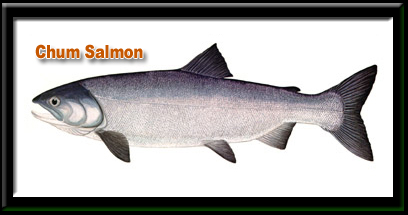 The chum salmon (Oncorhynchus keta) is a species of anadromous fish in the salmon family. It is a Pacific salmon, and may also be known as dog salmon or keta salmon, and is often marketed under the name silverbrite salmon. The name chum salmon comes from the Chinook Jargon term tzum, meaning "spotted" or "marked", while keta in the scientific name comes from the Evenki language of Eastern Siberia via Russian.
The chum salmon (Oncorhynchus keta) is a species of anadromous fish in the salmon family. It is a Pacific salmon, and may also be known as dog salmon or keta salmon, and is often marketed under the name silverbrite salmon. The name chum salmon comes from the Chinook Jargon term tzum, meaning "spotted" or "marked", while keta in the scientific name comes from the Evenki language of Eastern Siberia via Russian.
The body of the chum salmon is deeper than most salmonid species. In common with other species found in the Pacific, the anal fin has 12 to 20 rays, compared with a maximum of 12 in European species. Chum have an ocean coloration of silvery blue green with some indistinct spotting in a darker shade, and a rather paler belly. When they move into fresh water the color changes to dark olive green and the belly color deepens. When adults are near spawning, they have purple blotchy streaks near the caudal peduncle, darker towards the tail. Spawning males typically grow an elongated snout or kype, their lower fins become tipped with white and they have enlarged teeth. Some researchers speculate these characteristics are used to compete for mates.
Adult chum usually weigh from 4.4 to 10.0 kg (9.7 to 22.0 lb) with an average length of 60 cm (24 in). The record for chum is 19 kg (42 lb) and 112 cm (44 in) and was caught at Edie Pass in British Columbia.
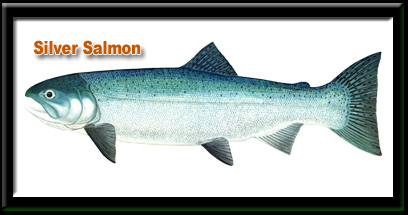 During their ocean phase, coho salmon have silver sides and dark-blue backs. During their spawning phase, their jaws and teeth become hooked. After entering fresh water, they develop bright-red sides, bluish-green heads and backs, dark bellies and dark spots on their backs. Sexually maturing fish develop a light-pink or rose shading along the belly, and the males may show a slight arching of the back. Mature adults have a pronounced red skin color with darker backs and average 28 inches (71 cm) and 7 to 11 pounds (3.2 to 5.0 kg), occasionally reaching up to 36 pounds (16 kg). They also have a large kype during spawning. Mature females may be darker than males, with both showing a pronounced hook on the nose.
During their ocean phase, coho salmon have silver sides and dark-blue backs. During their spawning phase, their jaws and teeth become hooked. After entering fresh water, they develop bright-red sides, bluish-green heads and backs, dark bellies and dark spots on their backs. Sexually maturing fish develop a light-pink or rose shading along the belly, and the males may show a slight arching of the back. Mature adults have a pronounced red skin color with darker backs and average 28 inches (71 cm) and 7 to 11 pounds (3.2 to 5.0 kg), occasionally reaching up to 36 pounds (16 kg). They also have a large kype during spawning. Mature females may be darker than males, with both showing a pronounced hook on the nose.
The traditional range of the coho salmon runs along both sides of the North Pacific Ocean, from Hokkaidō, Japan and eastern Russia, around the Bering Sea to mainland Alaska, and south to Monterey Bay, California. Coho salmon have also been introduced in all the Great Lakes, as well as many landlocked reservoirs throughout the United States.
In North America, coho salmon is a game fish in fresh and salt water from July to December, especially with light fishing tackle. It is one of the most popular sport fish in the Pacific Northwest of the United States and Canada. Its popularity is due in part to the reckless abandon which it frequently displays chasing bait and lure while in salt water, and the large number of coastal streams it ascends during its spawning runs. Its habit of schooling in relatively shallow water, and often near beaches, makes it accessible to anglers on the banks, as well as in boats.
The cutthroat trout (Oncorhynchus clarkii) is a fish species of the family Salmonidae native to cold-water tributaries of the Pacific Ocean, Rocky Mountains, and Great Basin in North America. As a member of the genus Oncorhynchus, it is one of the Pacific trout, a group that includes the widely distributed rainbow trout. Cutthroat trout are popular gamefish, especially among anglers who enjoy fly fishing. The common name "cutthroat" refers to the distinctive red coloration on the underside of the lower jaw. The specific name clarkii was given to honor explorer William Clark, coleader of the Lewis and Clark Expedition.
Cutthroat trout usually inhabit and spawn in small to moderately large, clear, well-oxygenated, shallow rivers with gravel bottoms. They also reproduce in clear, cold, moderately deep lakes. They are native to the alluvial or freestone streams that are typical tributaries of the rivers of the Pacific basin, Great Basin and Rocky Mountains. Cutthroat trout spawn in the spring and may inadvertently but naturally hybridize with rainbow trout, producing fertile cutbows. Some populations of the coastal cutthroat trout (O. c. clarkii) are semi-anadromous.
Several subspecies of cutthroat trout are currently listed as threatened in their native ranges due to habitat loss and the introduction of non-native species. Two subspecies, O. c. alvordensis and O. c. macdonaldi, are considered extinct. Cutthroat trout are raised in hatcheries to restore populations in their native range, as well as stock non-native lake environments to support angling. The cutthroat trout type species and several subspecies are the official state fish of seven western U.S. states.



![]()

![]()
Marlin E. Benedict
Fish Wrangell
PO Box 301
Wrangell, Alaska 99929

